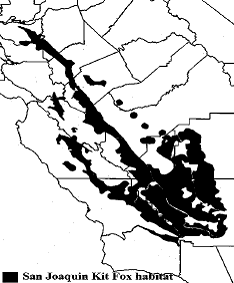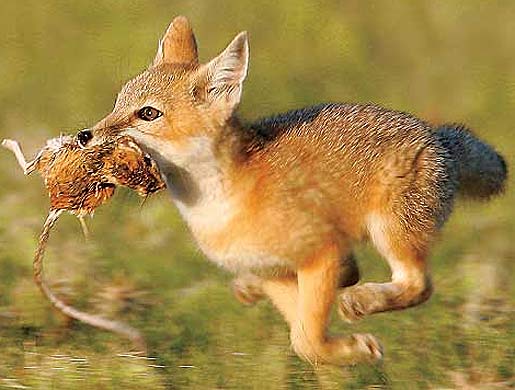San
Joaquin Kit Fox
Vulpes
macrotis mutica
Randy Sterbentz
Description and
Ecology:

San Joaquin Kit
Fox
(https://www.nwf.org/News-and-Magazines/National-Wildlife/Animals/Archives/2004/Poisoning-the-Imperiled.aspx)
The kit fox (Vulpes macrotis) is the smallest species of fox on Earth. The San Joaquin subspecies (Vulpes macrotis mutica) is the largest
of the kit fox species, growing to around 31.7 inches. There are only two subspecies of kit fox that
are recognized: the species that lives in the San Joaquin Valley and the
species that lives elsewhere (Vulpes
macrotis macrotis). Mercure et al. determined
that the kit foxes living in San Joaquin Valley had distinct habits compared to
other kit foxes, therefore classifying it as a subspecies of its own. (2)
San Joaquin kit foxes can have a
tan, buff, or greyish-silver coat, with a white or tan underbelly. They have a distinct black tip on their
tail. Their tail is bushy and long (11
inches), and is typically carried down and straight. (2)

(http://www.mnn.com/earth-matters/animals/stories/one-glimpse-of-these-baby-kit-foxes-and-youll-be-hooked-on-their-story)
They are decent diggers, modifying
California ground squirrels’ burrows to accommodate for their larger size. San Joaquin kit fox populations in an area
vary wildly. During child-rearing,
families can move 3-5 times a month. At
4 months of age, male San Joaquin kit fox pups will start to disperse to start
hunting on their own. Females may stick
with their mother for up to a year.
After 1 year, the kit foxes can reproduce, though they rarely do in the
first year of maturity. (1)
San Joaquin kit foxes are predators,
and as such, they help control populations of their prey. Being nocturnal, they typically hunt
nocturnal rodents, as well as San Joaquin antelope squirrels, desert
cottontails, ground-nesting birds, insects, and even grass. (2)
Geographic and
Population Change:

Current Range of
the San Joaquin Kit Fox
(http://lpfw.org/our-region/wildlife/san-joaquin-kit-fox/)
Historically, the San Joaquin kit
fox used to prowl the entire San Joaquin Valley. Their range has now been reduced to the edge
of the Valley, from southern Kern County, up to Contra Costa County. Pre-1930,
it is estimated there used to be as many as 12,134 kit foxes in the
Valley. As of 1975, it’s estimated there
were 6,961 kit foxes in the reduced range.
The majority of San Joaquin kit foxes currently live in the southern edge
of their range, with 41% of the population in Kern County and 10% in San Luis
Obispo County. (2)

(http://www.littleredmillinery.com/kit-fox-diet/)
List Date: Federal: 1967
(California: 1971)
Listing Status: Federal: Endangered
(California: Threatened)
Cause of listing
and Main Threats:
With the increased human development
that has gone on in the San Joaquin Valley, the natural environment for all San
Joaquin Valley inhabitants is being degraded.
Roads are fragmenting populations of kit fox, preventing them from
reaching one another. Developing the
land is causing collapses on kit fox dens, suffocating the foxes still
inside. Grazing lands are being used up
by livestock, degrading the habitat of the kit fox’s prey. (1)
Rodenticides are also impacting their
survivability, either by directly ailing them when they consume a poisoned
rodent, or by there not being as abundant of a source of rodents as they’re
being killed off. In addition to human
causes, other species such as the red fox and coyotes compete with the San
Joaquin kit foxes for the dwindling resources. (2)
All of these causes are resulting in the
endangerment of the San Joaquin kit fox.
The largest of these concerns is their habitat fragmentation. Without the ability for populations to
interact with each other, they will die off separately. (1)
Description of
Recovery Plan:
The primary goal of the recovery
plan is to secure the populations in three core areas: the Carrizo Plain
Natural Area in San Luis Obispo County; Natural land of western Kern County;
and the Ciervo-Panoche Natural Area of western Fresno and eastern San Benito
Counties. These lands are key locations
that help keep the San Joaquin community thriving. For the kit foxes, they serve as cornerstones
that allow satellite populations to exist nearby and still have somewhere to
return to safely. There are many
satellite populations that exist between these core populations, creating a
network of sorts connecting the core populations. If a core population goes extinct, that dramatically
reduces success for the other core populations.
These are also mostly public lands, which puts less of a burden on
private land owners. Maintaining these
lands and ensuring their sustainability will benefit not only the kit fox, but
also all species that claim these lands as their home. (2)
A secondary objective is more
research. Very little is known about the
San Joaquin kit fox: an accurate historical range/population, agricultural
abilities, distribution, interactions with Red foxes, etc. Surveys will be performed alongside
restoration efforts so more information can be gathered to better future
recovery plans. (2)
What Can You Do?:
If you don’t happen to have millions
of dollar laying around to purchase some public land to personally protect,
there are some small things you can do if live nearby the Valley. San Joaquin kit foxes are adaptable, so if an
urban environment comes to them, they can adapt to being scavengers. Reduce the use of rodenticides, seal trash
bags so kit foxes cannot get into them, and avoid attracting rodents and
squirrels to your home. Many other instances
can be found in the site linked in Other Resources. (3)
Other Resources:
Visit this site to inform yourself
on how to prevent harming San Joaquin kit foxes:

(http://tinmanphotoblog.com/10-reasons-why-everyone-should-do-wildlife-photography/)
Bibliography:
1) “Keep Me Wild: Kit Fox”. CA.gov. 2016. Web. December 1, 2016.
2) “San
Joaquin Kit Fox”. Defenders of Wildlife.
2016. Web. November 28, 2016.
3) Williams,
Daniel F., et al., “Recovery Plan for Upland Species of the San Joaquin Valley,
California.” U.S. Fish and Wildlife Service. 1998. Web. November 28, 2016.













